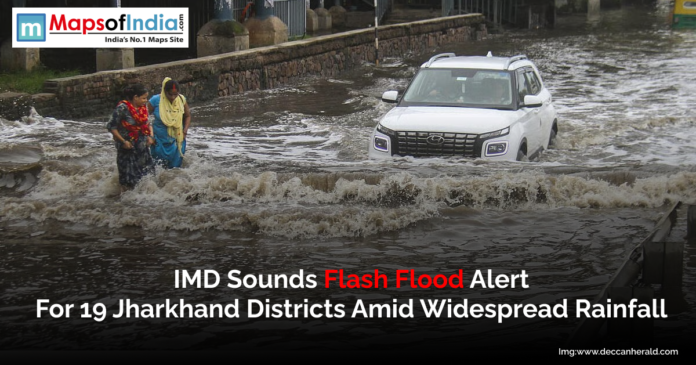India Meteorological Department (IMD) has issued a flash flood alert for 19 Jharkhand districts due to heavy and widespread monsoon rainfall in the region. The warning follows weeks of relentless rainfall, caused by an active monsoon system, which has left the ground swamped as well as the water levels in a number of rivers and streams high, to create the likelihood of widespread surface runoff and isolated flooding. Districts such as Ranchi, Dhanbad, East and West Singhbhum, Ramgarh, Bokaro, Garhwa, Palamu, Gumla, Simdega, Lohardaga, Latehar, Khunti, Hazaribagh, Koderma, Giridih, Jamtara, Deoghar, and Dumka, have been found to be susceptible to flash floods particularly flood prone low and riverine areas. Police have been put on full alert order and local governments have been advised to keep water bodies under surveillance and to get ready to respond in case of emergency. The residents within these areas have also been cautioned by the IMD to be careful and should not go anywhere near the swollen rivers or streams and they should also not leave their homes unless unavoidable. Schools in certain areas have been closed on precautionary basis and ready disaster response teams maintained. This continued rainfall is said to be due to the depression that had been created on the Bay of Bengal that had traveled on the mainland and the monsoon current has become more strong and this is seen by the continuous rain that occurred all over Jharkhand and the states that surround this area. The meteorological office has forecast that the intensity of rainfall might persist even in the coming 48 hours with chances of some isolated regions receiving very heavy rains.This has brought about concern over possible urban flooding, waterlogging and destruction of standing crops, especially paddy that is at present in the trans plantation stage. Excess water in the fields has already been experienced by the farmers, resulting in delays and destruction of the seedbeds. The constant rain has already started interfering with the lives of people in urban centres of the country, where traffic jams, flooded roads and power cuts are experienced in various towns and cities. The municipality has been advised to maintain the drainage system clear and to ensure rapid clearance of water in the areas of high importance. Up to this date, there has been no significant loss of life, but relevant authorities are keen on it as it gets up-to-date weather reports and warnings. The state government has also reminded the district administrations to liaise with the National Disaster Response Force (NDRF) and other rescue agencies to be prepared in the event of deterioration of the situation. People are urged to observe advisories issued about the weather, travel only where necessary and respond to authorities that are ensuring safety. As the monsoons have not yet stopped, with continued rainfall shortly, the alert by IMD can be viewed as a dire warning to take cautious steps in disaster management and be aware of the communities. Although rain is necessary in farming and to recharge groundwater, surplus rain is a real threat, particularly in areas where the infrastructure is weak and the drainage setup is unreliable. However, the following days will be critical in establishing the extent of damage, as the volume of rainfall as well as the level of readiness on administrative levels will be of central importance in limiting the effects of the damage and ensuring protection of lives in the regions under the Jharkhand state.










